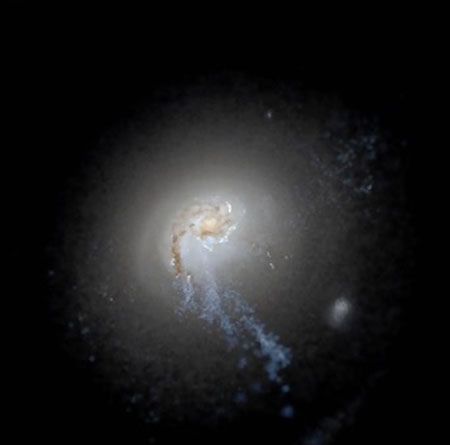Some of the scant stars dwelling in the Milky Way’s halo may have an unexpected origin: They may come from the galaxy itself.
New computer simulations suggest that the Milky Way’s disk behaves like a dissatisfied chef, chucking out the flour, eggs, and butter of star formation. But on their way out, these ingredients come together anyway, forming new stars that circulate in the halo that surrounds our galaxy.

Courtesy of Sijie Yu / UCI
Sijie Yu (University of California, Irvine) and his colleagues published remarkably realistic simulations supporting this scenario in the Monthly Notices of the Royal Astronomical Society. They make the case that a substantial fraction of the Milky Way’s stellar halo has an unexpected origin: the galaxy itself.
The Disk and the Halo
Most of the Milky Way’s stars circle its center from within the disk and central bulge that make up the most visible portion of our galaxy. All around this disk, though, a small fraction of stars also orbit the center within a roughly sphere-shape volume — but their orbits are far from circular. Out in this stellar halo, most stars travel on highly elongated orbits, moving largely radially toward or away from the galactic center.
Astronomers have long thought that most of these stars come from dwarf galaxies falling into the Milky Way. Our galaxy’s gravity pulls on these stellar groups, stretching them like taffy into long strings of stars.
Yet astronomers have also supposed that some of these stars may have formed within the halo, in situ. If dwarf galaxies can fall into the Milky Way, then so can clouds of gas. And as gas clouds fall through the halo, they might become compressed, setting off the chain reaction of gravitational collapse that ultimately births stars.
What Yu and his colleagues propose, though, is the opposite: What if the clouds didn’t fall in from outside? What if the gas clouds are coming from the Milky Way itself?
FIRE and Ice
Yu studied six simulated Milky Way-like galaxies produced by the so-called “Latte Suite,” a subset of the Feedback in Realistic Environments 2 simulation. FIRE-2 reproduces the growth and evolution of galaxies in unprecedented detail, accounting for feedback effects such as the wind blowing off newborn stars and the torrents of gas blasted away from supernovae.
Tracking the six galaxies, the researchers traced individual stars back in time, finding that between 5% and 40% of the halo stars originated in gas flung out of the galaxy’s center. Galaxy-scale outflows, arising in rounds of supernova explosions, were compressed into stars on their way out to the galaxy’s periphery.
Star-forming outflows are obvious in the visualizations: In one of the simulated galaxies, a dense gas cloud that was originally rotating as part of the disk was, over 40 million years, swept up in an outflow and started forming new, blue stars as it went.
In a visualization of an outflow event captured by the FIRE-2 simulation, the left frame above shows starlight (young stars are blue; brown shows where dust blocks the light), while the right frame above shows ionized gas.
Simulate and Check
While astronomers have seen clear evidence of galactic “superwinds” in numerous other galaxies, such as M82, similar signatures in the Milky Way remain ambiguous.
There’s subtler evidence of star-forming outflows in data coming from the European Space Agency’s Gaia satellite, which follows the motions of more than 1 billion stars in the Milky Way. By combining that data with maps of other stellar properties, astronomers can dig into the Milky Way’s past. For example, a star’s chemical abundance tells what generation it was born into: While more recent generations have more elements heavier than hydrogen and helium, older, more pristine generations have very few of these heavy elements. In maps that combine Gaia’s stellar motions with those stars’ chemical abundances, Yu says, “we can see structures similar to those produced by outflow stars in our simulations.”
But measuring halo stars is difficult, and there’s no smoking gun yet. Amina Helmi (University of Groningen, The Netherlands), who was not involved in this study, counters, “I think we need more data to be able to identify such stars, particular chemical abundances of distant halo stars.” Nevertheless, with predictive simulations such as these in hand, astronomers will know much better what to look for.
 3
3









Comments
Anthony Barreiro
April 29, 2020 at 6:51 pm
This is an interesting detective story. What will it take to get better spectra of halo stars? Will next-generation space- or ground-based telescopes be needed? Better spectrometers? Better data analysis?
You must be logged in to post a comment.
LarryKTM
May 1, 2020 at 2:46 pm
Here, I quote from the above article:
“... While newer generations have more elements heavier than hydrogen and helium, older generations have very few of these heavy elements.”
Is not the opposite true: as stars evolve, hydrogen and helium fusion reactions produce elements of higher atomic number?
Am I not understanding what “generations” implies? Thanks.
You must be logged in to post a comment.
Monica YoungPost Author
May 1, 2020 at 3:28 pm
I'll rephrase it: Should read "more recent generations (as in, younger stars) have more heavy elements.
You must be logged in to post a comment.
You must be logged in to post a comment.